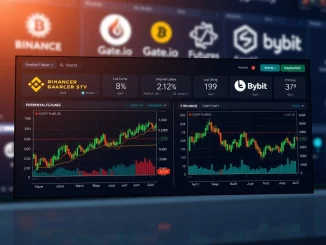
Are you feeling a chill in the crypto air? The latest Crypto Fear & Greed Index reading might be the reason. This key market sentiment indicator has just taken a significant dip, sliding seven points to land at 40. This shift isn’t just a minor fluctuation; it’s a move from the calm ‘Neutral’ zone straight into ‘Fear’ territory. For anyone involved in the cryptocurrency world, whether you’re a seasoned trader or just dipping your toes in, understanding what the Crypto Fear & Greed Index is telling us is crucial. Let’s dive deep into this shift and explore what it could mean for your crypto portfolio.
What Exactly is the Crypto Fear & Greed Index and Why Should You Care?
Think of the Fear and Greed Index as a mood ring for the crypto market. It’s designed to gauge the overall sentiment – are investors feeling greedy and bullish, or fearful and bearish? Created by Alternative.me, this index isn’t just a random number; it’s a composite score derived from analyzing various market factors. Ranging from 0 to 100, it provides a simple yet powerful snapshot of market emotions. A score closer to 0 screams ‘Extreme Fear’, suggesting investors are overly worried, which ironically, can sometimes present buying opportunities. On the flip side, a score near 100 signals ‘Extreme Greed’, hinting at a market that might be overheating and due for a correction.
Why is this important? Because market psychology plays a massive role in crypto price movements. Understanding the prevailing sentiment can help you make more informed decisions, whether you’re looking to buy, sell, or simply hold. It’s like having a peek into the collective mind of the crypto market!
Breaking Down the Numbers: What Makes Up the Crypto Fear & Greed Index?
The Crypto Fear & Greed Index isn’t based on guesswork. It’s calculated using a weighted average of six key market indicators, each providing a different perspective on market sentiment. Let’s break down these components:
- Volatility (25%): Measures the current and maximum drawdowns of Bitcoin, comparing it with the average values over the last 30 and 90 days. Unusually high volatility often signals fear.
- Market Momentum/Volume (25%): Compares the current market momentum and volume to the last 30 and 90-day averages. High buying volumes typically indicate greed, while low volumes can suggest fear.
- Social Media (15%): Primarily analyzes sentiment on Twitter, tracking hashtags and engagement to understand the general buzz and emotion around Bitcoin and other cryptos.
- Surveys (15%): Weekly crypto polls are conducted to directly gauge investor sentiment. While currently paused, this factor historically contributed valuable insights.
- Bitcoin Dominance (10%): Measures Bitcoin’s market cap relative to the total crypto market cap. Increased Bitcoin dominance can sometimes indicate a ‘flight to safety’ during fearful times.
- Google Trends (10%): Analyzes Google Trends data for Bitcoin-related search queries. Spikes in searches like ‘Bitcoin crash’ often correlate with fear.
Here’s a quick look at the components in a table:
[table]
| Factor | Weight | Sentiment Indication |
|————————–|——–|——————————————————|
| Volatility | 25% | High volatility = Fear |
| Market Momentum/Volume | 25% | High volume = Greed, Low volume = Fear |
| Social Media | 15% | Positive sentiment = Greed, Negative sentiment = Fear |
| Surveys | 15% | Bullish = Greed, Bearish = Fear |
| Bitcoin Dominance | 10% | Increased dominance (sometimes) = Fear |
| Google Trends | 10% | ‘Bitcoin crash’ searches = Fear |
[/table]
Why the Shift to ‘Fear’ Now? Decoding Crypto Market Sentiment
The drop in the Crypto Fear & Greed Index to 40, pushing it into the ‘Fear’ zone, suggests a shift in overall market sentiment. But what’s driving this fear? Several factors could be at play:
- Market Corrections: The crypto market is known for its volatility. Recent price corrections across various cryptocurrencies, including Bitcoin and Ethereum, can trigger fear as investors see their portfolio values decrease.
- Economic Uncertainty: Global economic factors, such as inflation concerns, interest rate hikes, and geopolitical tensions, can spill over into the crypto market, making investors risk-averse.
- Regulatory Scrutiny: Increased regulatory attention and potential clampdowns in different countries can inject fear into the market, as uncertainty looms over the future of crypto regulations.
- Negative News Cycles: Bearish news headlines, whether it’s about exchange hacks, project failures, or negative analyst predictions, can collectively dampen market sentiment and push the index towards fear.
It’s important to remember that fear in the market isn’t always a bad thing. In fact, contrarian investors often see ‘Fear’ as a potential signal to buy. As Warren Buffett famously said, “Be fearful when others are greedy, and greedy when others are fearful.”
Navigating the ‘Fear’ Zone: What Does This Mean for Bitcoin and Beyond?
So, the Fear and Greed Index is flashing ‘Fear’ – what should you do? Here are a few perspectives to consider:
- Potential Buying Opportunity?: Historically, periods of ‘Fear’ and ‘Extreme Fear’ have presented excellent buying opportunities. When the market is fearful, prices are often suppressed, creating chances to accumulate assets at lower prices. Think of it as a potential ‘discount’ on your favorite cryptos.
- Risk Management is Key: While fear can signal buying opportunities, it’s also a reminder of the inherent risks in the crypto market. Now is a good time to review your portfolio, ensure proper diversification, and manage your risk exposure. Don’t put all your eggs in one volatile basket!
- Long-Term Perspective: If you believe in the long-term potential of cryptocurrencies, short-term fear-driven dips can be less concerning. Focus on the fundamentals of the projects you’re invested in and avoid making emotional decisions based on short-term market fluctuations.
- Stay Informed, Stay Calm: Keep a close eye on market developments, but avoid panic selling. Understanding the reasons behind market movements and staying informed can help you make rational decisions even when fear is prevalent.
Actionable Insights: Leveraging the Fear & Greed Index in Your Crypto Strategy
The Crypto Fear & Greed Index is more than just a number; it’s a tool that can be integrated into your crypto investment strategy. Here’s how:
- Sentiment Confirmation: Use the index to confirm your own market sentiment analysis. If your analysis suggests a potential downturn, and the index also indicates ‘Fear’, it could strengthen your conviction.
- Timing Your Entries: Consider using ‘Fear’ periods as potential entry points for long-term investments. Conversely, ‘Greed’ periods might be times to take profits or reduce exposure.
- Market Awareness: Regularly check the index to stay aware of the overall market mood. This can help you anticipate potential market swings and adjust your strategy proactively.
- Combine with Other Indicators: Don’t rely solely on the Fear & Greed Index. Use it in conjunction with other technical and fundamental analysis tools for a more comprehensive market view.
In Conclusion: Is Fear a Friend or Foe in the Crypto Market?
The Crypto Fear & Greed Index slipping into the ‘Fear’ zone is undoubtedly a noteworthy event. It signals a shift in market sentiment that every crypto investor should be aware of. While fear can be unsettling, especially in a volatile market like crypto, it also presents potential opportunities. By understanding what drives the index, how to interpret its signals, and how to integrate it into your strategy, you can navigate these emotional market waters more effectively.
Remember, the crypto market is cyclical. Fear and greed are inherent parts of these cycles. Staying informed, maintaining a long-term perspective, and managing risk wisely are your best tools to thrive, regardless of whether the market mood is fearful or greedy. So, is fear a friend or foe? In the crypto market, perhaps it’s a bit of both – a challenge and an opportunity, depending on how you choose to respond.



